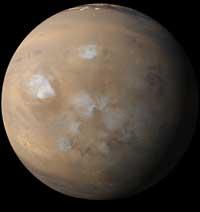Mars Oddysey probe detects large amounts of hydrogen on Mars

On Mars there are large underground areas rich in hydrogen. This hydrogen has been detected by a gamma-ray spectroscope carrying the Mars Odyssey probe. This instrument is used to detect the nuclei of atoms. The latest study identified areas rich in hydrogen, which is also one meter below the ground at most. This methodology was used by NASA in 1988 to investigate the craters of the Moon.
As in the case of the Moon, astronomers are discussing whether this identified hydrogen is of water molecules or not. They say there are many options for this compound to be frozen, but they have not obtained direct water evidence. In fact, the spectroscopy used does not allow detecting molecules, but atoms. Therefore, to know whether or not this hydrogen is in the form of water, they must study the soil of Mars differently.
To make all this known, NASA has prepared a press conference for Thursday.
Buletina
Bidali zure helbide elektronikoa eta jaso asteroko buletina zure sarrera-ontzian











